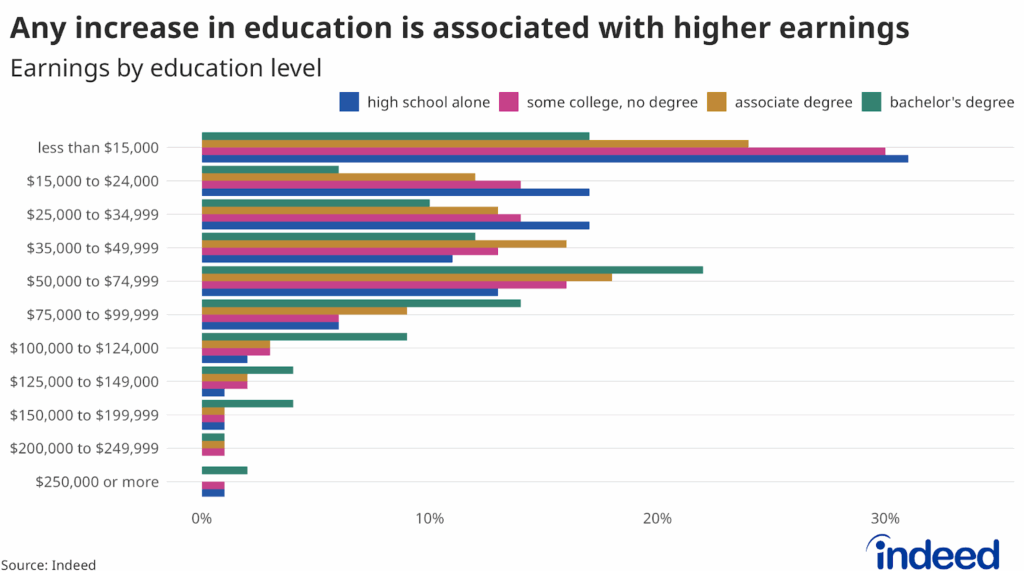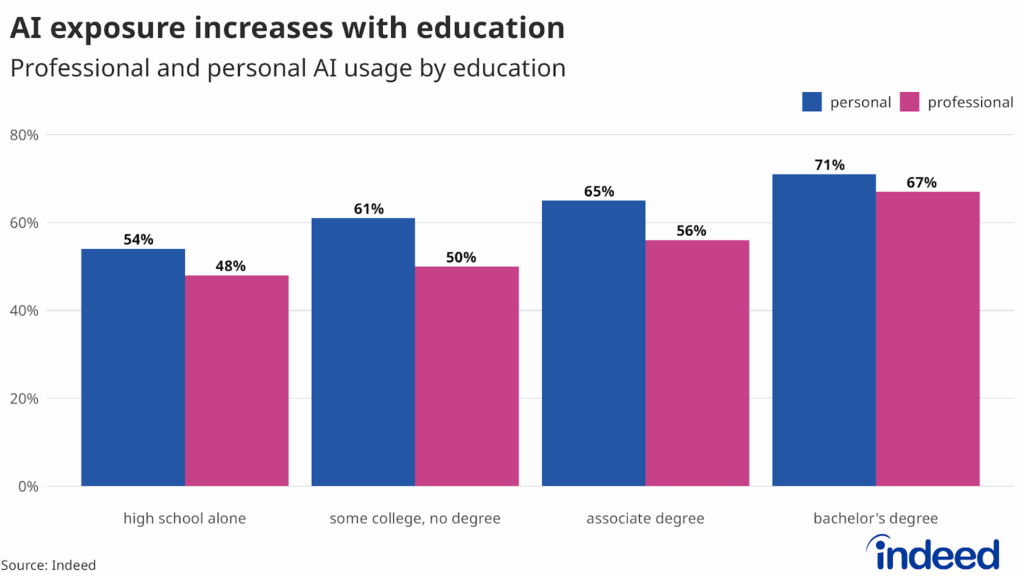Key points:
- Any increase in education is associated with an increase in pay, even outside of a four-year degree.
- Reskilling opportunities and exposure to AI within the workplace also increase with education.
- Despite better returns, 40% of those with some college experience but no degree cited a lack of education as an employment barrier, compared to 30% among those with only a high school diploma.
While the merit of a college degree is becoming increasingly contested, the value of education remains strong. A bachelor’s degree continues to be associated with higher employment rates and better earnings. But workers with an associate degree — or even some college but no degree — also fare better than those whose education ends at high school. The advantages of education also extend beyond monetary benefits, with opportunities for workplace reskilling and career growth increasing with higher levels of education.
Education still pays off
Today’s job market is challenging, particularly for those seeking employment for the first time. Despite a historically low overall unemployment rate, young workers are struggling to secure opportunities in what has become a stagnant labor market, marred by weak hiring and limited turnover. This stagnation affects nearly all new entrants, but its impact is particularly severe for young workers without a college degree.

Even as public debate about the value of higher education intensifies, it remains true that those with only a high school degree (or some college but no degree) experience higher unemployment rates and lower earnings than workers with a bachelor’s degree. This educational disparity persists despite estimates that 35% of all jobs require a bachelor’s degree or higher — a share expected to increase to 42% by 2031.
Weekly median earnings for those with a bachelor’s degree are $322 higher than for workers overall, a clear signal of the immediate financial benefits of having a degree vs not. However, even some college experience holds advantages over only holding a high school diploma, suggesting a general pattern: the more education one attains, the better the outcomes. New survey data from the Indeed Hiring Lab shows that 31% of respondents with a high school diploma alone were making less than $15,000 a year, compared to 30% for those with some college but no degree, 24% of associate degree holders, and just 17% for those with a four-year education. Because this survey includes all employment statuses (not just full-time), underemployment is a factor, as are differences in wages. According to the 2025 Indeed Workforce Insights Report — a national, population-weighted survey of more than 10,000 US residents — approximately 75% of high school graduates report earning less than $50,000 per year, compared with 71% of those with some college education and 65% of associate degree holders. However, less than half of bachelor’s degree holders (45%) reported earning less than $50,000/year. In other words, the financial payoff comes at the bachelor’s degree finish line.

Opportunities continue after college
Income isn’t the only advantage education provides. While at least half of respondents across all education levels said upskilling is a priority, a majority (57%) of workers with only a high school education reported having no access to employer-provided training, compared to 48% of those with some college but no degree, and 40% of associate degree holders. By comparison, just 33% of bachelor’s degree holders said they have no access to employer-provided skill development.

The rise of AI as a critical skill across industries further highlights this disparity. Because AI is relatively new, most workers must develop expertise outside traditional college programs. Yet, only 54% of high school graduates report using AI in their personal lives, compared to 61% of individuals with some college but no degree, 65% of those with an associate degree, and 71% of those with a bachelor’s-level education. In professional settings, usage drops even further: half, or even fewer, of both high school graduates and those with some college experience reported using AI at work, increasing slightly to 56% for those with an associate degree, and roughly two-thirds (67%) of bachelor’s degree holders.

Despite the advantages education provides at any level, 40% of those with some college but no degree reported that a lack of education and certification has been a barrier in finding a job — a startling 10 percentage points more than those with just a high school diploma, and 5 percentage points higher than those with a two-year degree. This difference in perception could be because those with some college but no degree are seeking jobs that are typically only attainable to degree holders, while associate degree holders and high school graduates had different expectations about their career trajectories. Regardless of sentiment, those with some college but no degree are still represented in a much wider range of occupations compared to those whose education ends at high school. And while many employers are lowering degree requirements in job postings, it’s clear that more education means more access to a variety of jobs, particularly well-paying ones with more training opportunities.
Conclusion
In a stagnant labor market, skepticism about the value of a degree has reached a fever pitch. Rising costs and uncertain job prospects make the investment appear less compelling. However, the advantages of education remain clear. A degree may not guarantee employment, but it consistently expands opportunity. Postsecondary credentials improve access to higher earnings, career advancement, and employer-sponsored reskilling — especially as artificial intelligence reshapes the workplace. Education is not a cure-all for economic stagnation. However, dismissing its value risks overlooking one of the most reliable tools for resilience and mobility in a shifting economy. Education completion at any level still opens doors.
Methodology
This analysis utilizes data collected from an online survey, conducted for Indeed Hiring Lab by YouGov, of 10,000 US adults, with results limited to individuals aged 25 and above for this research. Reported income refers to individual earnings, encompassing all employment levels and unemployment situations, including both part-time and full-time work. Sampling was random and representative by age, gender, education, and region in all markets, and by race, aligned to the US Census Bureau, American Community Survey, 2022. Fieldwork was conducted in May and June of 2025, with a total of n=80,936 interviews globally, and a minimum of n=10,000 interviews per market. This sample size provides a margin of error of ±1% at the 95% confidence level within each market.



